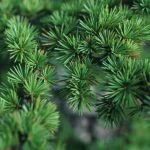| Common Name: |
Atlas Cedar |
| Botanical Name: |
Cedrus atlantica |
| Genus: |
Cedrus |
| Family: |
Pinaceae |
| Cultivation: |
Well-drained soil in sun. Cedrus atlantica tolerates chalky soils. To maintain a single leader, remove competing branches in autumn. Remove aging lower branches fluse with the bole in early spring. Honey fungus may attack trees. |
| Propagation: |
By seed sown in spring, after 21 days' moist chilling at 0-1°C (32-34°F); by grafting in late summer of winter. Cedrus atlantica f. glauca is usually grafted commercially, but comes fairly true from seed. |
| Harvest: |
Branches are chipped for oil distillation or dried for use in decoctions. |
| Native Region: |
Atlas Mountains of N Africa |
| Height: |
15-25m (50-80ft) |
| Width: |
5-10m (15-30ft) |
| Variations: |
Aurea
Is slow-growing, with yellow foliage when young, becoming green in older speciments.
f. fastigiata
Has an upright habit and blue-green leaves.
f. glauca
(Blue Atlas Cedar)
Has glaucous blue foliage. |
| Hardiness: |
Z6-8 |
| Parts Used: |
Wood, oil |
| Properties: |
A good antiseptic and fungicide that stimulates the circulatory and respiratory systems, and calms the nerves. The odor repels insects. |
| Medicinal Uses: |
Externally for skin diseases, ulcers, and dandruff, and as an inhalation for bronchitis, tuberculosis, and nervous tension. |
| Economic Uses: |
Wood is used in joinery and for making insect-repellant articles for storing textiles. Oil is used in perfumery, notably in jasmine-scented soap. |
| Bibliography: |
Encyclopedia of Herbs by Deni Brown Copyright © 1995, 2001 Dorling Kindersley Limited. pp 160-161.
|
